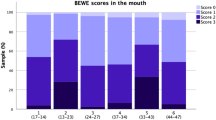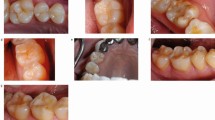Abstract
Aim To evaluate currently available methods for assessing and monitoring tooth wear in a general dental practice environment.
Method A questionnaire was developed and used to obtain data. Models were used to test the dentists' assessment of tooth wear. Ethical permission was obtained.
Results Twenty general dental practitioners were interviewed and 100% were aware of the use of study models, 50% about the use of photographs and 45% of the BEWE. Methods used to assess and monitor tooth wear were study models (75%), photographs (65%), BEWE (10%), Smith & Knight index (0%) and no method (15%). Sixty-five percent of dentists were unaware of any guidelines on monitoring tooth wear. In comparing serial photographs, no participant correctly identified all the wear changes and 25% thought a change had occurred when one hadn't. Statistical analysis showed a sensitivity of only 73% with a specificity of 75%. In comparing serial study models (same cases as used in the photographs), 55% of participants identified a change when no change occurred and 50-60% of participants were able to correctly identify if wear had or had not occurred. Participants graded the models according to BEWE. Statistical analysis of these results shows a sensitivity of just 69% with a specificity of only 55%. The inter-operator agreement (Fliess' Kappa) showed an even lower degree of agreement was found with only 0.12, which suggests only a slight level of agreement, less than that with photographs.
Conclusion Dentists do not seem to be aware of the current guidelines but do make reasonable attempts to monitor tooth wear. None of the currently available methods are ideal and even the use of serial study models is open to much inter-operator variability.
This is a preview of subscription content, access via your institution
Access options
Subscribe to this journal
Receive 24 print issues and online access
$259.00 per year
only $10.79 per issue
Buy this article
- Purchase on Springer Link
- Instant access to full article PDF
Prices may be subject to local taxes which are calculated during checkout



Similar content being viewed by others
References
NHS Digital. Adult Dental Health Survey 2009. 2009. Available online at https://digital.nhs.uk/dataandinformation/publications/statistical/adultdentalhealth-survey/adultdentalhealthsurvey2009summaryreportandthematic-series (accessed February 2020).
UK Data Service. Adult Dental Health Survey, 1998. 1998. Available online at https://beta.ukdataservice.ac.uk/datacatalogue/studies/study?id=4226 (accessed February 2020).
Pretty I A, Edgar W M, Higham S M. The validation of quantitative light-induced fluorescence to quantify acid erosion of human enamel. Arch Oral Biol 2004; 49: 285-294.
Chew H P, Zakian C M, Pretty I A, Ellwood R P. Measuring initial enamel erosion with quantitative light-induced fluorescence and optical coherence tomography: an in vitro validation study. Caries Res 2014; 48: 254-262.
Chan K H, Tom H, Darling C L, Fried D. A method for monitoring enamel erosion using laser irradiated surfaces and optical coherence tomography. Lasers Surg Med 2014; 46: 672-678.
Wilder-Smith C H, Wilder-Smith P, Kawakami-Wong H, Voronets J, Osann K, Lussi A. Quantification of dental erosions in patients with GERD using optical coherence tomography before and after double-blind, randomized treatment with esomeprazole or placebo. Am J Gastroenterol 2009; 104: 2788-2795.
Rakhmatullina E, Bossen A, Bachofner K K, Meier C, Lussi A. Optical pen-size reflectometer for monitoring of early dental erosion in native and polished enamels. J Biomed Opt 2013; 18: 117009.
Rakhmatullina E, Bossen A, Hoschele C et al. Application of the specular and diffuse reflection analysis for in vitro diagnostics of dental erosion: correlation with enamel softening, roughness, and calcium release. J Biomed Opt 2011; 16: 107002.
Park J, Choi D S, Jang I, Yook H T, Jost-Brinkmann P G, Cha B K. A novel method for volumetric assessment of tooth wear using three-dimensional reverse-engineering technology: a preliminary report. Angle Orthod 2014; 84: 687-692.
Al-Omiri M K, Harb R, Abu Hammad O A, Lamey P J, Lynch E, Clifford T J. Quantification of tooth wear: conventional vs new method using toolmakers microscope and a three-dimensional measuring technique. J Dent 2010; 38: 560-568.
Al-Omiri M K, Sghaireen M G, Alzarea B K, Lynch E. Quantification of incisal tooth wear in upper anterior teeth: conventional vs new method using toolmakers microscope and a three-dimensional measuring technique. J Dent 2013; 41: 1214-1221.
Grenness M J, Tyas M J, Osborn J E. Mapping a non-carious cervical lesion using stereoimagery and dental casts incorporating optical texture. J Dent 2009; 37: 191-197.
Rodriguez J M, Austin R S, Bartlett D W. In vivo measurements of tooth wear over 12 months. Caries Res 2012; 46: 9-15.
Rodriguez J M, Austin R S, Bartlett D W. A method to evaluate profilometric tooth wear measurements. Dent Mat 2012; 28: 245-251.
Mehta S B, Banerji S, Millar B J, Suarez-Feito J M. Current concepts on the management of tooth wear: part 1. Assessment, treatment planning and strategies for the prevention and the passive management of tooth wear. Br Dent J 2012; 212: 17-27.
Al-Malik M I, Holt R D, Bedi R, Speight P M. Investigation of an index to measure tooth wear in primary teeth. J Dent 2001; 29: 103-107.
Lee A, He L H, Lyons K, Swain M V. Tooth wear and wear investigations in dentistry. J Oral Rehabil 2012; 39: 217-225.
Bardsley P F. The evolution of tooth wear indices. Clin Oral Investig 2008; DOI: 10.1007/s00784-007-0184-2.
Vailati F, Belser U C.Classification and treatment of the anterior maxillary dentition affected by dental erosion: the ACE classification dental erosion. Int J Period Rest Dent 2010; 30: 559-571.
Smith B G, Knight J K. An index for measuring the wear of teeth. Brit Dent J 1984; 156: 435-438.
Bartlett D, Ganss C, Lussi A. Basic Erosive Wear Examination (BEWE): a new scoring system for scientific and clinical needs. Clin Oral Investig 2008; DOI: 10.1007/s00784-007-0181-5.
Olley R C, Wilson R, Bartlett D, Moazzez R. Validation of the Basic Erosive Wear Examination. Caries Res 2014; 48: 51-56.
De Carvalho Sales-Peres S H, De Carvalho Sales-Peres A, Marsicano J A et al. An epidemiological scoring system for tooth wear and dental erosive wear. Int Dent J 2013; 63: 154-160.
Bartlett D. Retrospective long term monitoring of tooth wear using study models. Br Dent J 2003; 194: 211-213.
Mehta S, Banerji S, Millar B, Suarez-Feito F. Current concepts on the management of tooth wear: Part 1. Assessment, treatment planning and strategies for the prevention and the passive management of tooth wear. Brit Dent J 2012; 212: 17-27.
Van't Spijker A, Kreulen C M, Bronkhorst E M, Creugers N H. Assessment of early attrition using an ordinary flatbed scanner. J Dent 2012; 40: 603-608.
Rodriguez J M, Bartlett D W. A comparison of two-dimensional and three-dimensional measurements of wear in a laboratory investigation. Dent Mat 2010; DOI: 10.1016/j.dental.2010.07.001.
Public Health England. Delivering Better Oral Health: an evidence-based toolkit for prevention. 2017. Available online at https://www.gov.uk/government/publications/delivering-better-oral-health-an-evidence-based-toolkit-for-prevention (accessed February 2020).
O'Sullivan E, Barry S, Milosevic A, Brock G. Diagnosis, Prevention and Management of Dental Erosion. 2013. Available online at https://www.rcseng.ac.uk/-/media/files/rcs/fds/publications/dental-erosion-2013.pdf (accessed February 2020).
Dental Protection Ltd. Record Keeping in England. 2015. Available online at https://www.dentalprotection.org/uk/hub/record-keeping (accessed February 2020).
Dixon B; Sharif M O; Ahmed F; Smith A B; Seymour D; Brunton P A. Evaluation of the basic erosive wear examination (BEWE) for use in general dental practice. Br Dent J 2012; 213: 128-129.
Bartlett D. A personal perspective and update on erosive tooth wear - 10 years on: Part 1 - Diagnosis and prevention. Br Dent J 2016; 221: 115-119.
Author information
Authors and Affiliations
Corresponding author
Rights and permissions
About this article
Cite this article
O’Hara, M., Millar, B. Evaluation of the assessment of tooth wear by general dental practitioners. Br Dent J 228, 423–428 (2020). https://doi.org/10.1038/s41415-020-1314-3
Published:
Issue Date:
DOI: https://doi.org/10.1038/s41415-020-1314-3
This article is cited by
-
The opinions of GDPs on the challenges of managing tooth wear in primary dental care
British Dental Journal (2023)
-
Objective assessment of simulated non-carious cervical lesion by tridimensional digital scanning
Clinical Oral Investigations (2021)



